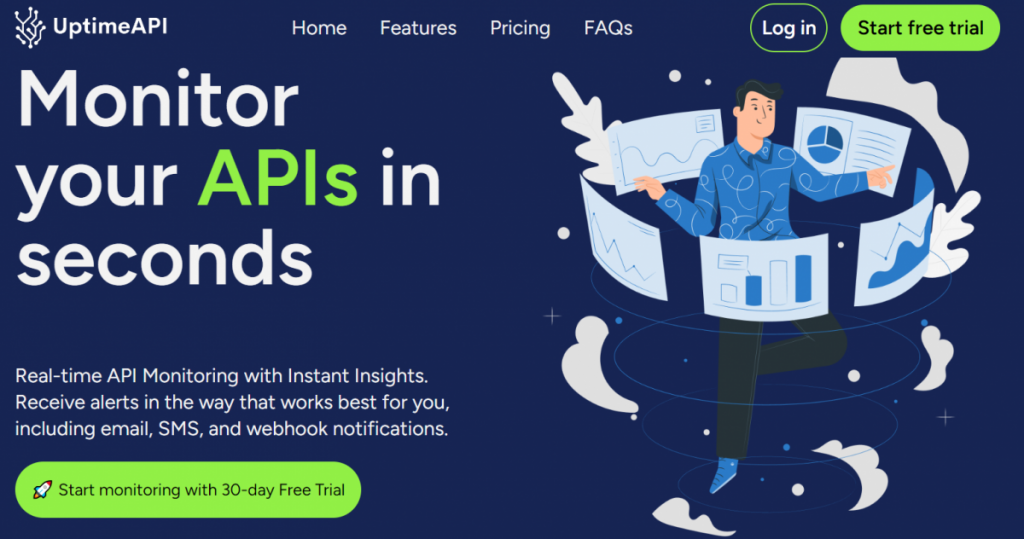In the realm of software development, the reliability and functionality of APIs are paramount. Ensuring that APIs operate seamlessly and efficiently is a crucial aspect of delivering high-quality applications. API testing plays a vital role in achieving this goal, allowing developers to validate the performance and functionality of their APIs under various conditions. In this easy tutorial, we’ll explore the fundamentals of API testing and guide developers on how to effectively use UptimeAPI for streamlined testing. Additionally, we’ll dive into the specifics of API responses, providing insights into what developers can expect during testing.
Understanding the Basics of API Testing

1. Why API Testing is Essential
API testing involves evaluating the performance, reliability, and functionality of APIs. It ensures that APIs not only meet their intended specifications but also perform optimally under different scenarios. Effective APIs testing helps identify and address potential issues early in the development process, minimizing the risk of bugs and ensuring a positive user experience.
2. Key Aspects of API Testing
APIs testing typically covers the following key aspects:
- Functionality Testing: Verifying that the API functions as intended, with correct inputs and expected outputs.
- Performance Testing: Assessing the API’s response times, throughput, and scalability under varying loads.
- Security Testing: Ensuring that the API is secure and protected against potential vulnerabilities.
- Reliability Testing: Validating that the API operates reliably over time, without unexpected failures.
Getting Started with API Testing Using UptimeAPI

Read More: Company profile APIUsage Cases
1. Create a UptimeAPI Account
To initiate APIs testing with UptimeAPI, the first step is to create an account on the UptimeAPI platform. This involves a simple registration process, and once completed, you’ll gain access to the UptimeAPI dashboard.
2. Add API Endpoints for Testing
Within the UptimeAPI dashboard, navigate to the settings or configuration section to add the API endpoints you wish to test. Specify the URLs, methods, and any required parameters for each endpoint.
3. Set Up Testing Parameters
Customize the testing parameters based on your testing goals. Define the frequency of tests, specific scenarios to simulate, and any authentication details required for the API endpoints.
4. Initiate API Tests
With your API endpoints and testing parameters configured, initiate the testing process. UptimeAPI will start sending requests to the specified API endpoints at the intervals you’ve defined.
5. Monitor Test Results
Utilize the UptimeAPI dashboard to monitor the results of your API tests in real-time. The dashboard provides insights into response times, HTTP status codes, and any errors detected during testing.
Understanding UptimeAPI’s API Responses in Testing
To make the most of UptimeAPI for APIs testing, it’s essential to comprehend the nature of API responses. Here’s a breakdown of what developers can expect:
1. HTTP Status Codes
UptimeAPI communicates the outcome of API tests through standard HTTP status codes. A 200 status code indicates a successful test, while 4xx or 5xx codes signify errors. Understanding these codes helps developers quickly identify and address issues in their APIs.
2. Response Time Metrics
Response time metrics are a crucial aspect of APIs testing. UptimeAPI includes response time information in its responses, providing developers with insights into how quickly their API endpoints respond under different conditions.
3. Error Details
In the event of errors, UptimeAPI offers detailed error information in its responses. This includes error codes, descriptions, and timestamps, facilitating quick diagnosis and resolution of issues uncovered during testing.
4. Historical Performance Data
UptimeAPI goes beyond real-time monitoring by storing historical performance data in its responses. This historical data allows developers to analyze trends over time, identifying patterns and potential areas for improvement in their APIs.
Best Practices for Effective APIs Testing with UptimeAPI
1. Comprehensive Test Case Creation
Define clear and comprehensive test cases that cover various aspects of your API, including different endpoints, input scenarios, and error handling.
2. Automation for Efficiency
Leverage automation to streamline repetitive tests. UptimeAPI allows you to schedule tests at regular intervals, enabling automated testing without manual intervention.
3. Simulate Real-World Conditions
Replicate real-world conditions during testing. Vary the load on your API and assess how it performs under different levels of traffic to ensure scalability.
4. Integration with CI/CD Pipelines
Integrate APIs testing into your CI/CD pipelines to ensure that testing is an integral part of your development workflow. This allows you to catch issues early in the development process.
Conclusion: Simplify API Testing with UptimeAPI
API testing doesn’t have to be a complex or daunting task. With UptimeAPI, developers can streamline the testing process and gain valuable insights into the performance of their APIs. By following the easy tutorial outlined above and understanding the nuances of UptimeAPI’s API responses, developers can enhance the reliability and functionality of their APIs, ensuring a seamless user experience. Start your APIs testing journey with UptimeAPI and take a proactive approach to building robust and efficient APIs for your applications.

